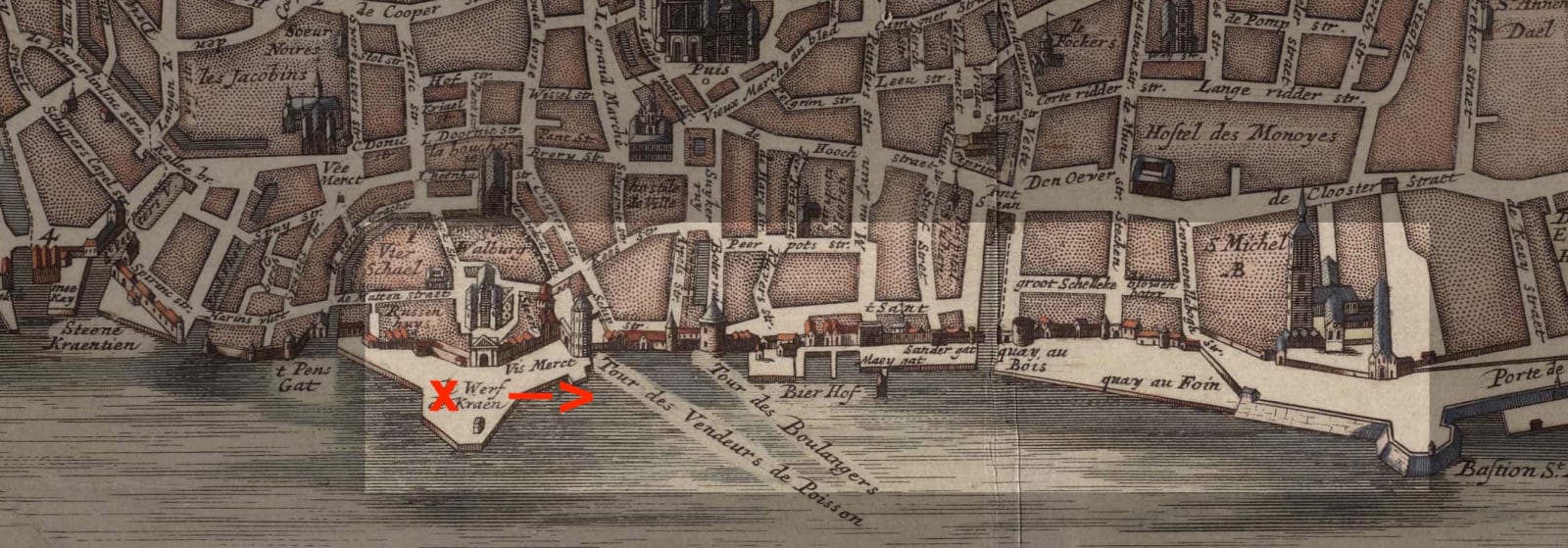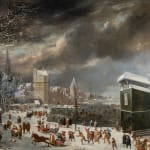Peeter van Bredael (Antwerp 1629 - 1719)
A View of the Antwerp Quayside, seen from the Werff
oil on canvas
163 x 237 cm
signed 'Peeter van Bredael f.', lower center
Shortly after arriving in Antwerp - the first destination on his trip through the Netherlands - on 2 August 1520, Albrecht Dürer drew a view of the Antwerp harbour, which...
Shortly after arriving in Antwerp - the first destination on his trip through the Netherlands - on 2 August 1520, Albrecht Dürer drew a view of the Antwerp harbour, which today is kept in the Albertina in Vienna. Dürer - who stayed no less than six times in Antwerp during his trip - was hugely impressed by the city, which was expanding at breakneck speed. Having overtaken Bruges by 1500 as the most important trading center north of the Alps, Antwerp was quickly becoming one of the foremost commercial and financial centers in Europe. Ideally located and easily accessible, Antwerp’s harbour played an enormously important role in the city’s economic development, which brought forth a vibrant cultural and artistic scene. The city’s commercial prowess was a source of pride, as is evidenced by 16th-century depictions of the river Scheldt and the Antwerp riverfront, which show off and celebrate the city’s economic and commercial primacy.
The Golden Age of Antwerp lasted for half a century after Dürers visit, but came to an end during the Eighty Years War. In Hans Bol’s panoramic View of Antwerp from 1583 (Rockoxhuis, Antwerp), the river Scheldt is still bustling with activity. However, the Fall of Antwerp in 1585 resulted in the loss of half the city’s population, as many protestants migrated to the Northern Netherlands. Antwerp entered a period of relative economic - though certainly not cultural - decline. Though traffic on the river Scheldt was still possible and Antwerp remained an important regional trade center, the imposition of tariffs, tolls and taxes meant that it’s role as an international commercial hub was mostly played out. Although - often very large - panoramic views of Antwerp were produced by seventeenth-century artists such as Jan Wildens, Bonaventura Peeters, Hendrik van Minderhout and others, depictions of the Antwerp harbour from that period are relatively few and far between, perhaps as its reduced economical importance caused it to loom less large in the city’s collective imagination. There are however notable exceptions, such as Sebastiaen Vrancx’ View of the Werf and Crane looking north (1608), now in a private collection , as well as his View of the Antwerp Quay by the Frozen Scheldt (1622), now in the Rijksmuseum (Amsterdam), which he maybe painted for Cornelis van der Geest.
The present large-size and impressive panoramic view of the city of Antwerp and the frozen river Scheldt, signed by Peeter van Bredael and executed ca. 1675 - 1700, may certainly be considered the artist's most ambitious and accomplished work. It depicts the same view as Vrancx’ 1622 picture, albeit from a slightly different viewpoint, with the viewer standing between the Werfpoort (Werf Gate) to the left and the Kranenhoofd (crane) to the right, looking south. The Werff (wharf), at about 70 meters wide, was the main dock of Antwerp harbour. It was dominated by the Kranenhoofd (crane), which stood almost 16 meters tall. This famous crane was built in 1546 and remained in use until 1811; it was demolished only in 1882/83 when the quays along the Scheldt were straightened. In Bredael’s picture, many major Antwerp landmarks can readily be identified: immediately to the right of the Werfpoort the spire of the Onze-Lieve-Vrouwekerk (Church of Our Lady) can be seen, while beyond stands the Viscooperstooren (Fishmongers’ Tower). Further on one can make out the Bakkerstooren (Bakers’ Tower) as well as, about half a mile away, the tower of the church of the Sint-Michielsabdij (Abbey of St Michael).
In addition to his accurate rendering of all these topographical details - notice, for instance, the wooden stalls of the fishmongers to the left of the Viscooperstooren - van Bredael populated his composition with a broad assortment of characters from all walks of life, engaged in a wide variety of activities. It is the depth of winter, with snow covering the trees, roofs and quays; the Scheldt is frozen over. The ice is full of people skating, playing and making merry, while horse-drawn sleighs and carnival revellers enliven the foreground. Although the picture is not dated, several harsh winters were recorded in the Antwerp annals during the fourth quarter of the 17th century: the Scheldt froze over in the winter of 1670, 1679/80, 1683/84 and 1690, often for weeks or even months on end. Surely one of these episodes must have inspired van Bredael in the creation of the present work.
Peeter van Bredael was born in Antwerp in 1629. Little is known about his early life. It has been suggested he was taught by David Ryckaert III ca. 1640-44 , although there seems to be no direct archival evidence for this. According to his portrait, which accompanies Cornelis de Bie’s entry on van Bredael , the painter spent some time in Spain, presumably ca. 1644-48. A trip to Italy can also not be excluded, especially given the many references to classical Roman ruins in his work. By early 1648 van Bredael was back in Antwerp, as he married Anna-Maria Veldeners on January 12; the couple had eight children. Van Bredael may be considered the founding father of a dynasty of Antwerp artists, as three of his sons (Jan Peeter, Alexander and Joris) as well as three of his grandchildren (Joseph, Jan Pieter the Younger and Jan Frans) became successful painters. In 1651 Van Bredael became a member of the Antwerp Guild of St Luke. He also joined the Schutterij (a local civil militia), later on obtaining the rank of captain. In addition to his sons Jan Peeter, Alexander and Joris, he also trained the well-known vedute painter Hendrik Frans van Lint, as well as a certain Ferdinandus Hofmans. Van Bredael was primarily a landscape artist, producing mainly Italianate landscapes - often featuring village feasts and cattle markets and sometimes commedia dell’arte scenes - and depictions of contemporary urban environments, such as the present picture. Occasionally he painted battle scenes. Like his contemporary Erasmus de Bie, he painted several views of Antwerp squares, such as The Old Ox Market, now in the Antwerp Museum of Fine Arts.
Provenance
With Carlo Sestieri, Rome, 1960’s;
Italian private collection.



